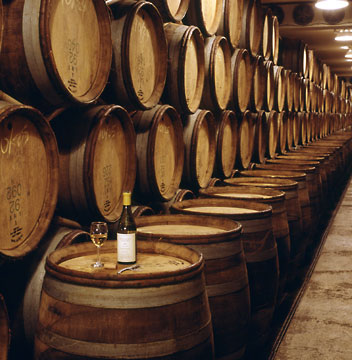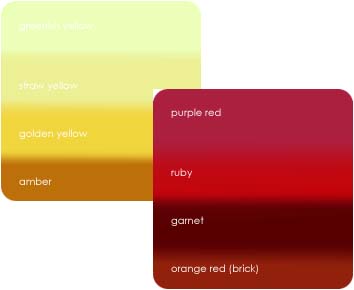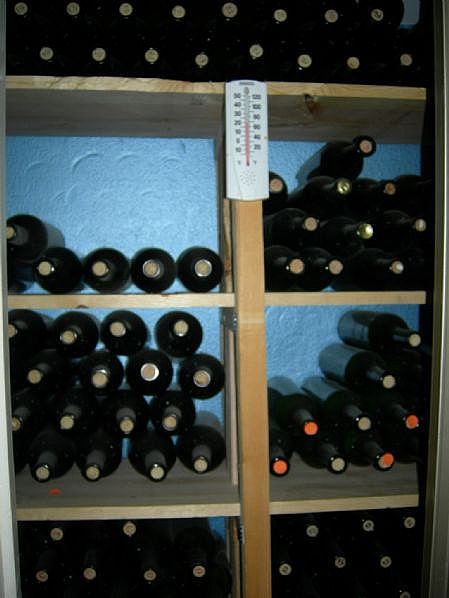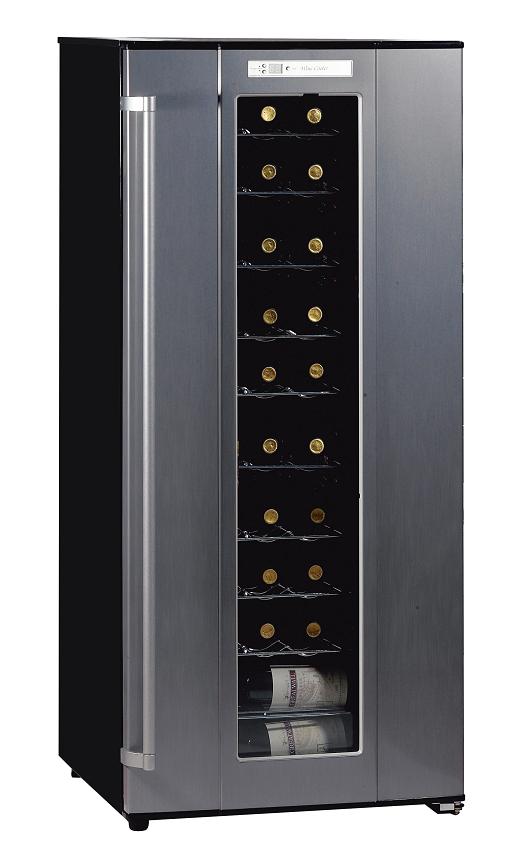
“To Cellar or Not to Cellar….That is the Question”
Try tasting a wine that is allowed to age
properly and you will experience the results of some
remarkable changes. The simple fruit and floral aromas of
the young wine are transformed into complex, earthy
bouquets. Red wines can take on qualities of wet earth,
leather, cedar and tobacco and develop soft silky yet
structured tannins. Chardonnay or Rieslings can evolve
minerality or mouth filling richness.
Do all wines age gracefully? The simple answer is no!
Qualities that make for an age-worthy wine start with
intensity of fruit extracts that can hold up in the bottle
over time. Other important factors such as acidity,
tannins, sugars and alcohol can play key roles as
preservatives that slow the natural oxidation of the wine
in the bottle. Finally, properly stored conditions are
required – cool temperature (around 57 F), low light, and,
most of all, a moist, slightly permeable cork.
The Test of Time
In order for a wine to show marked improvement and
complexity through aging, it must start out with the
correct properties. Most wines do not have these
properties and are made to be consumed in a short period
following bottling and distribution – usually within the
eight hours after purchase. But, even these wines may
benefit from a short period of bottle aging so that the
shock of bottling and vibrations during shipment can work
their way out. Usually, these are lighter bodied white or
red wines that demand fresh crispness, a fruit-driven
flavors or just a little softening of the initial tannins
for maximum enjoyment.
Wines meant to be drunk young include dry, fruity new-
world style wines such as Sauvignon Blanc, unoaked
Chardonnay, fruit-driven red wines like Aussie Merlot and
Shiraz, or lighter Sangioveses, and Spanish Rioja (Crianzas).
There are many wines such as the more heavily
oaked reds such as Cabernet Sauvignon, Merlot, Syrah and
even oaked Chardonnay, and good vintages of German
Riesling, and the wines from the best Chenin Blanc
producers in the Loire Valley of France that benefit
greatly from bottle aging. Other obvious choices for aging
are fortified or concentrated wines (e.g. Vintage Port,
Maderia, Sauterne, Ice Wines).
The Process of Aging
As wines age, many of their characteristics change….
both red and white wines tend to darken and even derive
a slight to significant brownish tinge. This is natural
and is a visual cue that you have a well aged, old wine,
or that you have a problem if it occurs in a young wine.
Red wines will particularly take on a dark sediment,
and some white wines can form white tartaric acid
crystals. This is to be expected and requires care when
handling and pouring so as not to transfer particulates into
the wineglass. Decanting may be imployed, but take care to
decant and serve the wine quickly as an aged wine can
lose its favors more rapidly than a young wine.
As mentioned before, one of the most noticable changes in
an aged wine is the flavor profile. Strong fruit aroma
and flavors evolve and meld with other non-fruit qualities
normally referred to as the wine’s aged bouquet. Harsh
young tannins and brisk acitity are transformed into a
softer, silky and more balanced character.
Getting Started
If you want to start aging wine, you can go low or high
end. For starters, just find a cool, dark place –
preferably not in the kitchen (too hot) and not in direct
sunlight. A windowless closet on the lowest floor of your
house and not on an outside wall will be best. For short
term aging – 1 to 3 years this will usually work just
fine particularly if you can get a place with an average
temperature less than 70 F.

The next level up is to get a small to large wine cooler
unit. These come in various sizes that can hold from 20
to 500 bottles. One word of wisdom is to get one larger
than you initially expect to need (maybe hold up to two
times the number of bottles you think you will need).
Most people find out that they like the aged qualities of
wine and acquire more wine than originally expected.
Another important factoid, putting a cooler in a garage
especially in a hot climate is not a good idea. Most
coolers do not have the capacity to handle the heat and
will break down just after the warranty ends. (Been there,
done that).

You can also go big scale and actually put in a wine
cellar. This is a major investment and requires having
some space (not necessarily in a basement) that can be
converted. Companies will design and install it or you
can buy the parts and do the installation yourself.
My recommendation is to drink most white wines within
three years after purchase and do the same with most red
wines within five years. Save longer term aging (5-10
years) for only the best and most substantial wines from
the best vintages and producers.
For Texans, looking to lay down a few of Texas’ finest,
I suggest the following:
3 to 5 years or longer
Becker Vineyards, Reserve Cabernet Sauvignon
http://www.beckervineyards.com/wines/Res_Cab.htm
5 to 10 years
Llano Esatacado, Viviano (Super Tuscan Blend – Cabernet/
Sangiovese) http://www.llanowine.com/2005Viviano.aspx
Note: I just opened a bottle of this wine after 5 years
on Friday at a local family-run, Italian restaurant. It held
up nicely – still quite lively and fruit-filled. This wine
could easily could have aged another 3-5 years.
Fall Creek Vineyards, Meritus (Cabernet/Bordeaux Blend)
http://www.fcv.com/meritus.php
Many more age worthy Texas wines are available.
For further advice on aging specific wines, check the
vintage charts and aging recommendations from noted
experts. The following links provide examples:
Wine Enthusiast Vintage Chart:
http://www.winemag.com/Media/PublicationsArticle/WE%20vintage%20chart.pdf
Wine Spectator Home Page – Expert advice for aging (well worth
subscribing to get full access to their complete listings):
http://www.winespectator.com/Wine/Free/WS_Wine_Ratings/0,4519,,00.html
Your Voice: Respond with your wine aging questions.

Designing custom wine cellars
provided by: Cygnus
Designing the perfect wine cellar requires knowing how clients plan to use it as well as creating the right atmosphere; temperature and humidity control are two factors that can either positively or negatively affect the aging process of wine. And because wine is an investment for most homeowners, it’s important to utilize a wine cellar designer early in a project so the proper setup is created.
Most wine cellar designers suggest storing wine in an environment of 55 to 65 degrees and between 50 to 70 percent relative humidity. To maintain constant temperature and humidity, proper insulation is suggested. “We stay away from fiberglass insulation because it can literally get saturated inside the wall unless one has a good vapor barrier. In a 2×4 wall, we like to go with 3½ in. of ridged polyurethane. That means it will have a foil cover on both sides of it which acts as a vapor barrier,” says Patrick Wallen, owner of Artistic Wine Cellars, San Rafael, Calif.
Proper insulation offers the versatility of placing the wine cellar anywhere in a house. “It’s just a matter of constructing the room properly. We recommend having R-13 on the walls and R-19 on the ceilings, then a moisture-resistant drywall and a door of exterior grade with weatherstripping around it,” says Matt Helm, Southern California design consultant for Cincinnati-based Wine Cellar Innovations.
A refrigeration unit is just as important as the insulation. “There are two types of refrigeration: a ductless split system and an air-handler split system. Both operate with a compressor outside, which is similar to a central air-conditioning system for a regular home. The ductless system has a unit that is mounted on the wall in the wine cellar. That one is very easy for remodels or jobs where space is an issue. The other is a forced-air system with supply and return vents inside the cellar with the runs hidden in the walls,” Helm says. “It’s a much more finished and cleaner look.”
Because maintaining constant temperature and humidity is so important, some companies offer technology to monitor these factors. “We manufacture wine cooling units that can call a homeowner if it’s too hot or cold to tell them they need to check it,” says India Hynes, owner and president, Vinotemp Corp., Rancho Dominguez, Calif. “We also have a tracking system with an inventory panel.”
Where to begin
At the beginning of the design process, many designers prefer to sit down with a homeowner for an interview process. “We want to determine his buying styles, how his collection has grown over the past few years, where he thinks it’s headed for the next 10 to 15 years, and what kinds of bottles he buys. We need to know if he buys magnums or double magnums — for long-term investments or if he primarily buys 750 ml,” Helm says.
Once the buying style is determined, designers then will focus on racking and appearance. “We focus much more on the form: what people can do to make it their own, what type of wood choices they’d like to see on the inside and how they are going to personalize the wine cellar,” Helm adds.
Wine cellar designers stress the importance of knowing if the client plans to use it for bulk storage or to show off their wine. “If it’s just for storage, then we’ll include a solid wall of wine. If the homeowner wants to show it off, we have a presentation rack that will break up a wall or different depths of racks,” says Doug McCain, owner, Wine Master Cellars, Denver.
If homeowners plan to show off their wine, it’s important to rack the bottles in a manner that clearly shows off the labels. “We can do high reveals, waterfalls or cascades to show off the wine bottles,” says Luis Mora, founder and CEO of Grotto Custom Wine Cellars and Cabinets, Aliso Viejo, Calif.
Proper racking is important with regard to the cork. Bottles should be stored horizontally so the cork is in contact with the wine. The temperature in the room also can affect the cork. “If the room is any dryer than expected, corks would dry out, and any wetter, mold would develop on the bottles,” Mora adds.
Most racks are made of All Heart redwood due to its resistance to decay and mildew. “Sixty percent of our sales include All Heart redwood. It’s beautiful and has character but it’s getting scarce as we go on,” Mora says.
Wine cellar clients like to set their wine cellars apart and are starting to move to other types of woods, Helm adds. “I do a lot of things in hunter and mahogany, and walnut is becoming popular. Then there are the people who are truly over the top and choose Purple Heart redwood,” he says.
Not all wine racks are made of wood, such as with Wine Master Cellars that offers a steel racking system. “We have different frames that we can use to attach differently than wood racks. We can go around corners and curved walls, and put racks completely in a corner,” McCain says.
Designers interviewed by Residential Design & Build say there’s not much difficulty in designing wine cellars, as long as they are included early in the project. “When it comes to specifications, builders and architects will be better served to go to someone like me who specializes in wine cellars,” Wallen says. “The perfect time to call us is when the space has been framed but nothing has been roughed in.”
Cellar demand rising
The demand for wine cellars has increased as more people get into the lifestyle and hobby of drinking wine. “Wine is becoming much more a part of our everyday culture. Twenty years ago, hardly anyone drank wine and if they did, they weren’t drinking fine or aged wine,” Helm says.
The future of wine cellars will continue to increase in demand as more homeowners recognize these spaces can add resale value to their homes. “I have clients who don’t even drink wine but just want a wine cellar in their house — it’s like keeping up with the Joneses,” Wallen says.
The next step in the evolution of wine cellars is to enter the popular world of green products. “I’ve been waiting for the green builders to call me and look for different man-made products for wine cellars. Even though our wood is done with sustainable harvest, every local town is adopting green building processes,” Wallen adds. “It’s just a matter of time when we move into building wine cellars with only man-made products.”